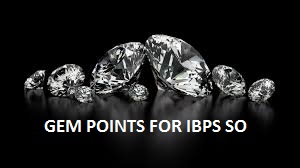Hello Aspirants,as we all know only few days are left for IBPS SO exam.So, we are starting a new series ” Gem points ” in this regard.learn them by heart.Share and discuss in comment section.We will gear up level day by day starting from very basics.So,Put your Seatbelts on and join us in the journey to be a specialist officer.
1)The method of communication in which transmission takes place in both directions, but only one direction at a time is called Half Duplex
2)Error detection at the data link level is achieved by Cyclic Redundancy Code
3)The topology with highest reliability is:Mess Topology
4)”BAUD” rate means the rate at which the signal changes
5)Start and stop bits are used in serial communication for synchronisation
6)Unmodulated signal coming from a transmitter is know as Baseband signal
7)ARPANET network uses dynamic or adaptive routing.
8)The Residual Error Rate measures the number of lost or garbled messages as a fraction of the total sent in the sampling period.
9)In session layer, during data transfer, the data stream responsible for the “control” purpose (i.e control of the session layer itself) is Capability Data
10)The Network topology that supports bi-directional links between each possible node is Mesh.
11)In a broad Sense, a railway track is an example of half Duplex
12)PAN network has connectivity range up to 10 meters.
13 Unicode Represents symbol or characters used in any language.
14)Correct method for full duplex mode of communication is: Both stations can transmit and receive data at the same time.
15)A data communications system has 5 components
The five components are :
1. Message – It is the information to be communicated. Popular forms of information include text, pictures, audio, video etc. Text is converted to binary, number doesnt converted, image is converted to pixels, etc.
2. Sender – It is the device which sends the data messages. It can be a computer, workstation, telephone handset etc.
3. Receiver – It is the device which receives the data messages. It can be a computer, workstation, telephone handset etc.
4. Transmission Medium – It is the physical path by which a message travels from sender to receiver. Some examples include twisted-pair wire, coaxial cable, radio waves etc.
5. Protocol – It is a set of rules that governs the data communications. It represents an agreement between the communicating devices. Without a protocol, two devices may be connected but not communicating.
16)00 represents a pixel that pixel is known as Black Pixel
17)Time required for a message to travel from one device to another is known as:Transit time
18)If one link fails, only that link is affected. All other links remain active. Which topology does this? – Star Topology
19) OSI model means:Open systems interconnection
20)Fibre Optic Cable transport signals in the form of light.
21)Twisted pair wires, coaxial cable, optical fiber cables are the examples of: Wired Media
22)Twisted Pair Cable is used in communications is referred to as unshielded twisted-pair (UTP)
23) Guided Media VS unguided media.Guided media is guided one.example- twisted pair cable,fibre optical wire,copper wire.
Unguided :- Here information is transmitted by sending electromagnetic signals through free space and hence the name unguided media, as the signals are not guided in any specific direction or inside any specific medium
24)Switching at the network layer in the Internet uses the datagram approach to:Packet Switching
25) IPV4 is also known as a connectionless protocol for a packet-switching network that uses the Datagram approach





